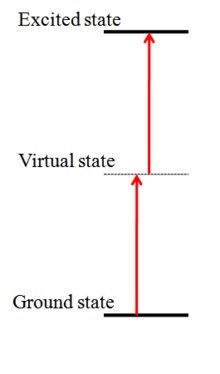Two-photon absorption (TPA or 2PA) or two-photon excitation or non-linear absorption is the simultaneous absorption of two photons of identical or different frequencies in order to excite a molecule from one state (usually the ground state) to a higher energy, most commonly an excited electronic state. Absorption of two photons with different frequencies is called non-degenerate two-photon absorption. Since TPA depends on the simultaneous absorption of two photons, the probability of TPA is proportional to the square of the light intensity, thus it is a nonlinear optical process.[1] The energy difference between the involved lower and upper states of the molecule is equal or smaller than the sum of the photon energies of the two photons absorbed. Two-photon absorption is a third-order process, with absorption cross section typically several orders of magnitude smaller than one-photon absorption cross section.
Two-photon excitation of a fluorophore (a fluorescent molecule) leads to two-photon-excited fluorescence where the excited state produced by TPA decays by spontaneous emission of a photon to a lower energy state.

Schematic of energy levels involved in two photons absorption
https://en.wikipedia.org/wiki/Two-photon_absorption
No comments:
Post a Comment